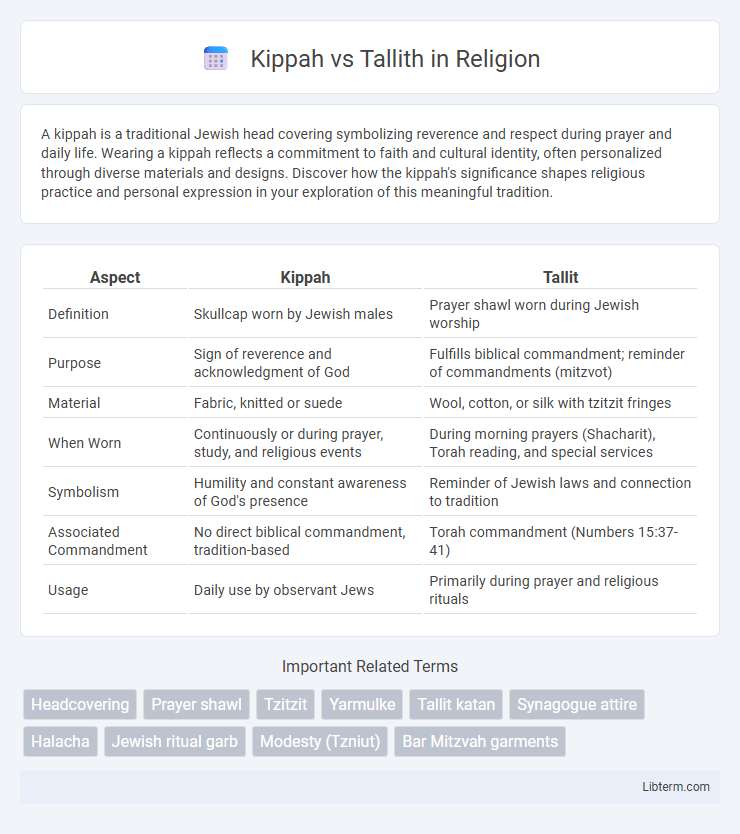A kippah is a traditional Jewish head covering symbolizing reverence and respect during prayer and daily life. Wearing a kippah reflects a commitment to faith and cultural identity, often personalized through diverse materials and designs. Discover how the kippah's significance shapes religious practice and personal expression in your exploration of this meaningful tradition.
Table of Comparison
| Aspect | Kippah | Tallit |
|---|---|---|
| Definition | Skullcap worn by Jewish males | Prayer shawl worn during Jewish worship |
| Purpose | Sign of reverence and acknowledgment of God | Fulfills biblical commandment; reminder of commandments (mitzvot) |
| Material | Fabric, knitted or suede | Wool, cotton, or silk with tzitzit fringes |
| When Worn | Continuously or during prayer, study, and religious events | During morning prayers (Shacharit), Torah reading, and special services |
| Symbolism | Humility and constant awareness of God's presence | Reminder of Jewish laws and connection to tradition |
| Associated Commandment | No direct biblical commandment, tradition-based | Torah commandment (Numbers 15:37-41) |
| Usage | Daily use by observant Jews | Primarily during prayer and religious rituals |
Introduction to Jewish Religious Garments
Kippah and Tallith are essential Jewish religious garments symbolizing reverence and spirituality in Jewish culture. The Kippah, a small skullcap worn on the head, signifies respect and acknowledgment of a higher presence during prayer and daily life. The Tallith, a fringed prayer shawl, is traditionally draped over the shoulders during morning prayers and special occasions, embodying the commandments of the Torah and devotion to Jewish faith.
What is a Kippah?
A Kippah, also known as a yarmulke, is a small, rounded skullcap traditionally worn by Jewish men to fulfill the religious requirement of covering the head as a sign of reverence and recognition of a higher authority. It differs from a Tallith, which is a rectangular prayer shawl with fringes (tzitzit) worn during prayer to fulfill the biblical commandment of wearing garments with fringes. The Kippah symbolizes humility and respect, while the Tallith emphasizes observance and connection to mitzvot through its visible commandment-related design.
Understanding the Tallith
The tallith, also known as a prayer shawl, is a rectangular garment traditionally worn during Jewish prayers, symbolizing commandments and spiritual devotion. Made of wool or silk, it features fringes called tzitzit on its four corners, fulfilling a biblical commandment from Numbers 15:38-40. Unlike the kippah, which covers the head as a sign of reverence, the tallith drapes over the shoulders, serving as a tactile reminder of faith and religious obligations during prayer.
Historical Origins of the Kippah
The Kippah, also known as a yarmulke, traces its origins to early Jewish customs symbolizing reverence and humility before God, with earliest references found in the Talmud. Unlike the Tallith, a prayer shawl with origins deeply rooted in biblical commandments from the Book of Numbers, the Kippah evolved more as a cultural and religious identity marker during the medieval period. Its usage spread across Jewish communities as a visible sign of piety and respect, distinguishing it from the Tallith's primarily liturgical function.
The Evolution of the Tallith
The evolution of the tallith, a traditional Jewish prayer shawl, dates back to biblical times when it was initially a simple rectangular garment used for modesty and prayer. Over centuries, the tallith incorporated symbolic fringes called tzitzit, fulfilling the commandment in Numbers 15:38-40 and serving as a physical reminder of the mitzvot. Unlike the kippah, which primarily covers the head symbolizing reverence, the tallith envelops the body during prayer, emphasizing spiritual devotion and continuity through evolving design and ritual significance.
Symbolic Meanings: Kippah vs Tallith
The kippah symbolizes reverence and humility before God, serving as a constant reminder of divine presence in everyday life. The tallith represents spiritual devotion and the fulfillment of biblical commandments, especially during prayer, with its fringes (tzitzit) symbolizing adherence to God's laws. Together, these garments embody different facets of Jewish identity: the kippah reflects personal awareness of holiness, while the tallith signifies collective commitment to tradition and faith.
Ritual Importance and Usage
The kippah, a small skullcap worn primarily during prayer, symbolizes reverence and acknowledgment of God's presence in Jewish rituals. The tallith, a fringed prayer shawl, holds greater ritual significance as it fulfills the biblical commandment to wear tzitzit, serving as a constant reminder of religious duties. While the kippah is often worn throughout the day by observant Jews, the tallith is typically donned during morning prayers and specific ceremonies, emphasizing their distinct roles in Jewish worship.
Differences in Design and Material
The Kippah is a small, rounded cap typically made from fabric, suede, or crocheted yarn, designed to fit snugly on the crown of the head. In contrast, the Tallith is a large rectangular prayer shawl made from wool, cotton, or silk, featuring distinctive fringes (tzitzit) at its corners as commanded by Jewish law. While the Kippah serves as a symbol of reverence and identity, the Tallith functions primarily as a garment worn during prayer, emphasizing its ritual significance.
Cultural and Community Significance
The Kippah, a small skullcap, symbolizes Jewish identity and reverence in everyday life and religious practices, signifying humility before God. The Tallith, a prayer shawl worn during morning prayers, represents spiritual devotion and community unity through its fringes (tzitzit), prescribed by biblical commandments. Both garments reinforce cultural heritage and communal belonging, with the Kippah often worn across various settings and the Tallith typically reserved for formal worship.
Kippah and Tallith in Modern Jewish Practice
The kippah and tallith hold significant roles in modern Jewish practice, with the kippah symbolizing reverence and humility before God, commonly worn during prayer, study, and daily activities by many Jewish men and some women. The tallith, a fringed prayer shawl worn during morning prayers and synagogue services, serves as a tangible reminder of the commandments and Jewish identity. Both garments are deeply embedded in ritual observance, reflecting continuity between ancient traditions and contemporary spirituality within Jewish communities worldwide.
Kippah Infographic

 libterm.com
libterm.com